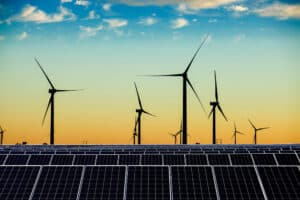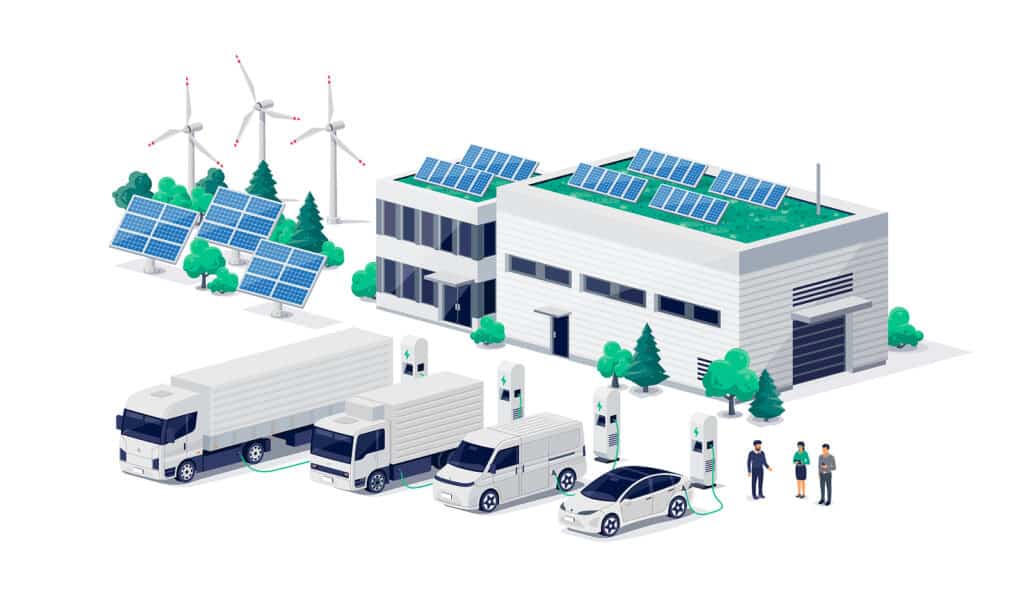Top Renewable Energy Companies of the Day
As we delve into the realm of sustainable communities, it's exhilarating to witness American solar and wind generation breaking records today. The surge in renewable energy adoption not only benefits consumers with lower costs but also brings about positive environmental changes. As cities and towns across the nation aspire to become more sustainable, they are increasingly embracing renewable energy technologies like solar panels, wind turbines, and hydroelectric power to power their homes, businesses, and public facilities.
What are Renewable Energy Companies?
Renewable energy companies, also known as green energy companies, are organizations that specialize in the production, development, and distribution of clean and renewable sources of energy. Unlike conventional energy companies that rely on fossil fuels, renewable energy companies harness naturally replenishing resources such as sunlight, wind, water, geothermal heat, and biomass to generate electricity and heat. These companies play an integral part in the global efforts to combat climate change, reduce greenhouse gas emissions, and minimize the dependence on finite and environmentally harmful energy sources.
Types of Renewable Energy Companies
Renewable energy companies play a pivotal role in shaping a sustainable future by capitalizing on diverse technologies to harness renewable resources. These forward-thinking enterprises encompass a wide range of specializations, each focused on maximizing the potential of different clean energy sources. Some of the most prominent types of renewable energy companies include:
Solar Power Companies
These companies focus on capturing sunlight through photovoltaic panels or solar thermal systems, converting it into electricity or heat for residential, commercial, and industrial applications. They design and implement solar power installations, ranging from rooftop arrays to large-scale solar farms, contributing significantly to reducing greenhouse gas emissions and promoting energy independence.
Wind Energy Companies
Specializing in harnessing the kinetic energy of the wind, these companies develop and operate wind farms equipped with turbines to generate electricity. They meticulously evaluate potential wind sites, design efficient wind turbine installations, and integrate them into power grids to provide a reliable and sustainable energy source.
Hydropower Companies
Hydropower companies utilize the gravitational force of flowing water to generate electricity. They design and manage hydroelectric plants that harness the energy from rivers, dams, or tidal currents, offering a stable and clean power supply. Hydropower's flexibility in managing peak demand and providing grid stability makes it a crucial component of the renewable energy mix.
Biomass Energy Companies
Focused on utilizing organic materials like agricultural residues, wood pellets, or biodegradable waste, biomass energy companies convert these resources into bioenergy through processes like combustion, gasification, or anaerobic digestion. They contribute to reducing waste, promoting sustainable forestry practices, and providing renewable heat and electricity options.
Geothermal Energy Companies
Geothermal energy companies tap into the Earth's heat from deep underground to generate electricity or provide direct heating and cooling. They drill geothermal wells and set up power plants to harness this constant and dependable source of energy, significantly reducing greenhouse gas emissions and enhancing energy resilience.
Ocean Energy Companies
These innovative enterprises explore the vast potential of the ocean's energy, including wave energy, tidal energy, and ocean thermal energy conversion. Ocean energy companies develop cutting-edge technologies and infrastructure to harness the immense power of the sea, offering a continuous and predictable source of clean electricity.
Energy Storage Companies
Vital for optimizing renewable energy integration and ensuring grid stability, energy storage companies focus on developing advanced battery technologies, compressed air energy storage, pumped hydro storage, and other energy storage solutions. These companies play a crucial role in storing surplus energy from intermittent renewable sources and releasing it during peak demand periods.
How Do Renewable Energy Companies Work?
Renewable energy companies play a pivotal role in the sustainable energy landscape, employing a multi-faceted approach to ensure the efficient generation and integration of clean power. The intricate workings of these companies involve a series of well-structured steps, each aimed at harnessing renewable resources and contributing to a greener future. Let's delve into more detail about how renewable energy companies operate:
Resource Identification and Assessment
The journey begins with extensive research and data analysis to identify the most suitable renewable energy resources for a given location. Solar energy companies meticulously assess the solar irradiance potential, wind energy companies study wind patterns, speeds, and consistency, while hydroelectric power companies analyze water flow rates and river capacities. Geothermal companies evaluate subsurface heat potential, and ocean energy companies study wave heights and tidal patterns. This comprehensive resource assessment is crucial to determine the feasibility and potential output of the renewable energy project.
Project Development and Financing
Once a promising site with abundant renewable resources is identified, the project development phase commences. Renewable energy companies collaborate with investors, financial institutions, and government agencies to secure the necessary funding. They navigate complex regulatory procedures, obtain permits and licenses, and conduct thorough environmental impact assessments to ensure compliance with environmental regulations and community needs.
Construction and Installation
With the necessary approvals and financing in place, renewable energy companies initiate the construction and installation phase. This involves setting up the infrastructure required to harness the identified renewable resource. Solar power companies deploy photovoltaic panels or solar thermal systems, wind energy companies install wind turbines, hydroelectric power companies construct dams and turbines, and geothermal energy companies drill wells and build power plants. Biomass energy companies establish facilities for converting organic materials into energy. This phase demands careful planning, engineering precision, and adherence to safety standards to ensure a successful and efficient energy facility.
Operations and Maintenance
Once the renewable energy facility is operational, the company transitions to the operations and maintenance phase. A dedicated team of technicians and engineers monitor the system round-the-clock to ensure smooth functioning. Regular maintenance, inspections, and repairs are conducted to optimize performance, maximize energy output, and extend the life of the equipment. This continuous monitoring ensures the reliability and longevity of the renewable energy installation.
Energy Distribution and Integration
Renewable energy companies collaborate with utility companies and power grid operators to facilitate the distribution of clean power to consumers. The generated energy is fed into the power grid, where it integrates with electricity from other sources. Due to the intermittent nature of some renewables, such as solar and wind, renewable energy companies employ sophisticated technologies like energy storage solutions and smart grid management to balance supply and demand, ensuring a stable and resilient energy grid.
Where Can You Find Renewable Energy Companies?
Renewable energy companies are becoming increasingly prevalent as the demand for sustainable energy grows worldwide. Here are some key sources to find reputable renewable energy companies:
American solar and wind generation breaking records

Last month, American solar and wind generation broke new records. According to the U.S. Energy Information Administration (EIA), renewable energy accounted for 10 percent of the nation's electricity generation. Although wind and solar energy have been growing for decades, these sources are finally breaking records. The first record came on March 29 when wind energy produced more electricity in one day than it did during that time last year. A similar record was set on April 3 when California's power grid briefly went down due to wind energy.
In the United States, solar and wind power installations are on the rise. The country will add about 60 gigawatts of net new generating capacity by the end of 2024. That's almost four times the amount of capacity installed ten years ago. By 2024, the combined total will produce enough energy to power 11.9 million homes. This surge in clean energy combined with a historic drop in emissions will put the U.S. on track to reach its Paris climate change goals.
With costs dropping, renewable energy is rapidly becoming more affordable. In 2020, US utilities plan to bring in 7.6 gigawatts of utility-scale wind and solar power. Last month, a wind farm in Oklahoma brought close to a gigawatt of new electricity online. The cost of wind and solar power has also decreased dramatically, and they are now being integrated into the national electricity grid without sacrificing their reliability. The future of renewable energy depends on the rapid deployment of clean, renewable energy.
In the fourth quarter of last year, the US installed a total of 4,751 megawatts of photovoltaic capacity, up 41% from 2012. Another record was set for concentrating solar power: 410 megawatts were installed. The fourth quarter, in particular, saw the largest amount of solar power installations. That's almost one-fifth of the total installed capacity. Those numbers are impressive, and it's important to keep these records in perspective.
Cost to consumers is decreasing
In recent years, renewable energy has become more affordable for consumers, especially for households that don't have to purchase expensive power from fossil fuels. According to the World Economic Forum, the cost of solar, wind, and other renewables has dropped as much as 82% since 2010. The cost of wind energy has fallen even more, with the cost of producing and selling wind power dropping below $0.04/kWh. Renewable energy companies are able to provide electricity at a reduced price for consumers, and this is resulting in a drop in cost.
Sweden and Denmark have developed extensive incentives for renewables, including a complex ‘Green Certificate' scheme, which shifts the subsidy cost onto the customer. In Denmark, surplus wind power is sold at zero price to the Nordic power pool, and its economic cost is only a fraction of that. Italy legislated a cost of about EUR 18 cents per kWh for wind power, which is less than half the cost of fossil fuels.
Germany's Renewable Energy Sources Act gives renewables priority for power dispatch and grid access. The act is regularly amended to reflect technological and market changes. For example, the initial tariff for wind energy is EUR 5.02 c/kWh for 20 years, after which it drops to a basic tariff of around EUR 9.2 c/kWh, and 15 c/kWh for offshore wind. Germany's renewable energy consumption accounts for 7.5% of the country's total electricity supply.
As renewable energy becomes more affordable, the costs of fossil fuel power are also decreasing. Wind and solar power have become the most cost-effective sources of electricity in the US and UK, while fossil fuel power costs range from 5-18 cents/kWh. Renewable energy companies are also increasing market share and reducing emissions. This is good news for consumers! They're reducing the cost of electricity while increasing affordability for all power consumers.
Impact on the environment

The goal of conservationists and renewable energy companies is to curb climate change, but the industry is largely unaware of its negative impacts. Increased mining is damaging biodiversity, and mining for battery materials will only worsen the problem. And, as climate change is widely reported, it will worsen human migration patterns and worsen weather patterns. So, what can renewable energy companies do to avoid these negative impacts? In short, it should focus on the environmental benefits and social responsibility of its products.
Environmental impact analysis is critical when assessing the environmental and social impact of renewable energy projects. The use of renewable energy technologies can cause environmental and social impacts, including air and water pollution, excessive water use, and wildlife habitat destruction. Environmental impacts are typically similar to those of any other type of industrial development. Environmental licensing may be costly. And, project-scale impacts can affect the rate at which renewable energy is deployed. But, there are ways to minimize these impacts, including using alternative energy sources and encouraging distributed generation technologies.
Switching from fossil fuels to renewables can reduce carbon emissions. Switching to renewable energy sources can reduce chemical and food-and-beverage processing companies' global carbon emissions by up to 40 percent. If this shift is implemented at a 50 percent rate in water-stressed countries, these companies' emissions could decrease by as much as eighty percent. They would also save on water, which is important for industries such as food and beverage processing.
While biomass is the least polluting renewable energy resource, the process of burning solid waste in garbage-to-energy power plants produces significant amounts of air pollution. Wind and solar, on the other hand, cause minimal pollution. However, the construction and disposal of solar and wind energy facilities can have negative effects on the environment. There are also negative environmental effects of concentrated solar plants and wind turbines. Aside from the environmental impacts, these projects may disturb wildlife habitats and cause high rates of juvenile mortality.
The environmental impact of renewable energy companies is largely determined by where they operate. In places where there is scarce land for agriculture, biomass energy generation may have a more significant impact on the environment. It may also compete with food production. Meanwhile, technologies that require significant amounts of water for production could cause water shortages. Therefore, careful decisions must be made regarding the deployment of specific technologies. In the U.S. and China, there are many factors that must be considered.
Investment opportunities

A new Jefferies survey focuses on investment opportunities in renewable energy companies. Investors are most interested in solar and wind energy but are also interested in battery storage, which has been a growing focus in the industry. According to the Energy Information Agency, half of our electricity will come from solar and wind sources by 2022, so there will be more focus on battery storage than ever. With these findings, there are plenty of investment opportunities for investors in renewable energy companies.
Although there are risks, these investments have a proven track record of high returns. Historically, investors have benefited from renewable energy companies that had a good strategy and implemented it efficiently. While this industry is maturing, consolidation is normal. As an investor, you will need to be sophisticated and risk-tolerant to take the time to identify and evaluate investment opportunities in renewable energy companies. IRENA's Sustainable Energy Marketplace showcases several types of funds and financial instruments that are available to meet the needs of investors.
While the public markets have been a volatile environment for investors, it's important to note that there are some perks. Many of these companies are not yet profitable, but they can offer investors the chance to take advantage of the current climate. The downside of the renewable energy market is that it's extremely difficult to predict when the industry will recover. The public markets are volatile because of the rapidly evolving technology. As a result, many companies have failed or gone bankrupt. This also means that new business models and financing structures are not yet well-established.
Some investors are interested in carbon capture and direct air capture, but the potential for commercial viability is limited. Another emerging clean energy source is green hydrogen. It's gaining popularity, but surprisingly, only 5% of investors registered in this sector. Regulatory pressure is also increasing in North America, where net-zero targets are now mandatory. This trend is further complicated by the growing regulation of ESG and net-zero targets. Jefferies is battling with climate information, capital climate disclosures, and a more stringent regulatory environment.
Conclusion
As I reflect on the information about renewable energy companies, I can't help but feel inspired and hopeful about the future of clean and sustainable energy. The fact that American solar and wind generation is breaking records brings a sense of pride and accomplishment, knowing that we are making significant strides in reducing our carbon footprint. The decreasing costs of these technologies not only benefit consumers but also make renewable energy more accessible to everyone, fostering a sense of inclusivity in the fight against climate change.
Understanding the crucial role played by renewable energy companies in shaping a sustainable future, I am impressed by the diversity of their specializations, each contributing uniquely to harnessing clean energy sources. The solar power companies capturing sunlight to generate electricity, the wind energy companies harnessing the power of the wind, the hydropower companies utilizing the energy of flowing water, and the geothermal and ocean energy companies tapping into the Earth's natural resources—all these endeavors symbolize human ingenuity and determination to secure a greener tomorrow.
Sources:
https://www.irena.org/sustainable-energy-marketplace
https://about.jefferies.com/news/2021/04_19_renewable_energy_investment

